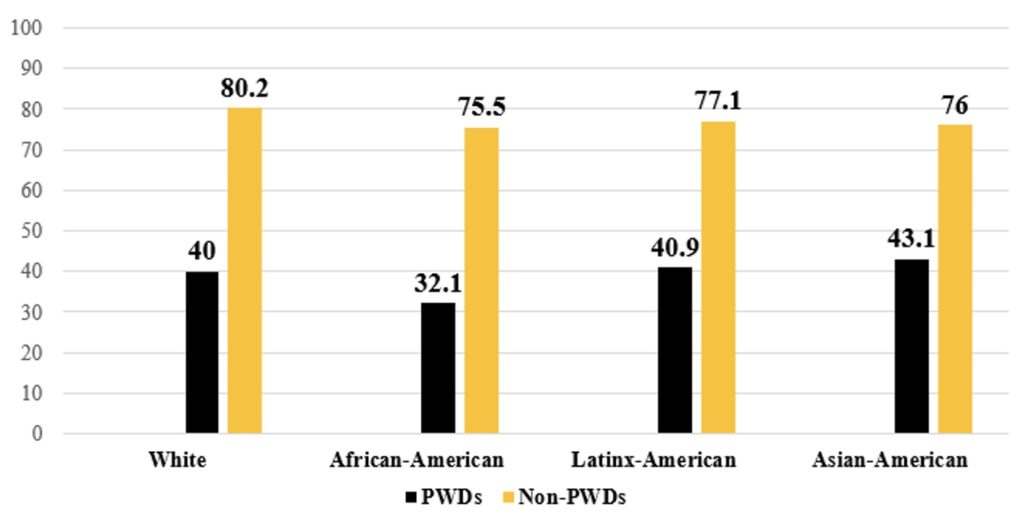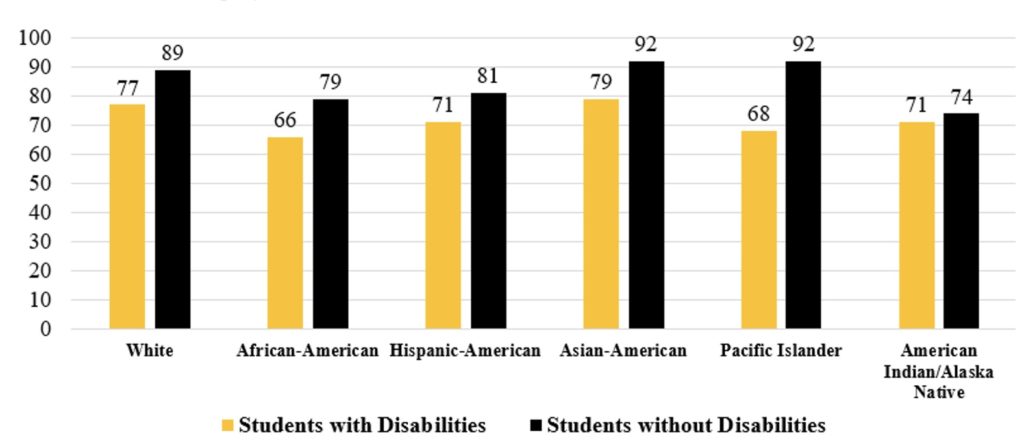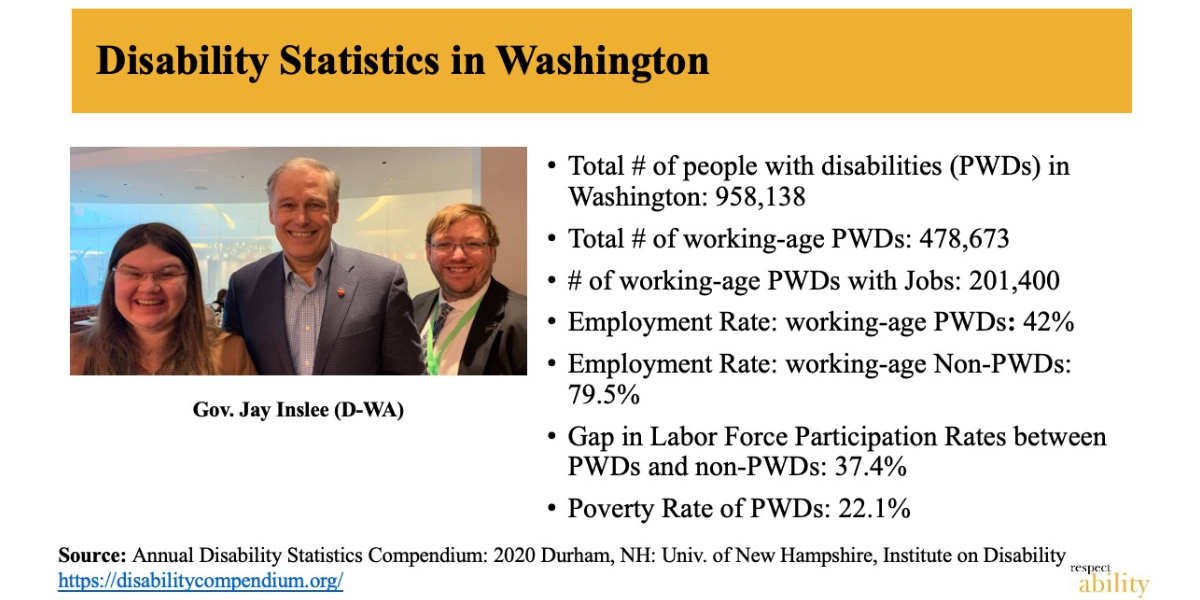Download the Slide Deck
Seattle, WA, June 10 – This week, Washington state’s Workforce Training and Education Coordinating Board met to discuss policies and priorities for moving the Evergreen State’s economy forward. In response, the national disability inclusion organization RespectAbility weighed in with their perspective on how to advance new opportunities for workers with disabilities and close crucial gaps in Washington’s economy.
“When it was passed with broad, bipartisan support in 2014, the Workforce Innovation and Opportunity Act (WIOA) invested unprecedented resources into efforts to get people with barriers to employment into the labor force,” said the Honorable Steve Bartlett, former Member of Congress, the former Mayor of Dallas and current Chairman of RespectAbility. “Now, after the pandemic that has reshaped our economy, it is time to implement policies that will drive a truly equitable recovery that helps people with disabilities and other marginalized communities get back to work.”
There are 478,673 working-age Washingtonians living with some form of disability. In the economic expansion prior to COVID-19, fully 42 percent of them had jobs. However, because of COVID, more than 1 million workers with disabilities have lost their jobs nationwide. Now, as more Americans get vaccinated and more people get back to work, it is crucial that policy makers implement best practices.
Earlier this week, RespectAbility’s team convened an engaged and excited group of self-advocates to talk about the need for better solutions and new opportunities for Washingtonians with disabilities. The insights brought forward at the convening helped to shape the final content of RespectAbility’s public testimony.
“Our economy is at its best when all people, including people with disabilities, can earn an income and become independent, just like anyone else,” said Philip Kahn-Pauli, RespectAbility’s Policy and Practices Director. “Companies including Microsoft, JPMC, Coca-Cola and others have seen that talented people with disabilities can bring unique experiences, innovation and determination to organizations. It is time for more Washington-based companies to benefit from the skills and insights that workers with disabilities bring to the table.”
In their comments to the Workforce Training and Education Coordinating Board, RespectAbility’s team articulated a vision focused on closing gaps in outcomes, tracking metrics around disability and race, fighting stigmas that harm the employment aspirations of millions of Americans with disabilities, expanding Project SEARCH to help meet the needs of the caring economy and encouraging entrepreneurship.
RespectAbility’s full testimony is presented below:
Dear Washington Workforce Training and Educating Coordinating Board,
Thank you very much for the opportunity to offer our comments on how to improve policies in the months ahead as businesses resume their full operations, and more people get vaccinated as well as drive innovative approaches to apprenticeship through a lens of equity, intersectionality, and disability.
Adding Vocational Rehabilitation Department Representation to the State Workforce Development Board
We consider it a missed opportunity that the state vocational rehabilitation agency is not represented on the Workforce Development Board. In order to fully provide a holistic model of career services across disability, this department should join the Department of Services for the Blind, which is already represented.
Collect and Track Disability Data and Progress Across Government as Well as Disaggregate It by Race and LGBTQ+ Status
All too often, disability status is not a data point captured by existing government programs. When disability is tracked, decision makers sometimes fail to fully recognize the diversity within the disability community and fail to orient to the specific challenges facing our community. This becomes particularly challenging once we include intersections with LGBTQ + and Black and Indigenous People of Color (BIPOC) populations. Yet, these intersections are not tracked, making it difficult to look at intersecting challenges, and almost completely erasing certain categories, like trans folks with disabilities, even though they are very prominent. Just to get a sense of the prominence of this diversity, we share some interesting information on people with disabilities who are LGBTQ+, Black, Latinx, and AAPI, which you can reach by following these links. By including race and LGBTQ+ status as tracked categories of people with disabilities, government entities will begin to be able to disaggregate and track the crucial intersectional issues facing these populations as they connect to disability. This is a powerful asset not fully represented by current data collection. The economic stability of BIPOC people with disabilities was significantly behind even prior to the pandemic. In the economic expansion prior to COVID, among the 478,673 working-age Washingtonians with disabilities, only 42 percent of them had jobs. Further, the labor force for workers with disabilities was even more complicated when you begin to look at the intersection of race and disability. Digging deeper into the data on working-age people with disabilities reveals a more complex story and suggests how the Board can work towards a better, more equitable future. For example, there are 20,962 working-age African Americans with disabilities living in Washington state, and out of that number, only 7,105 or 33.9 percent had jobs. In contrast, among the 46,579 working-age Hispanic/Latinx people with disabilities living in Washington, 24,647 or 52.9 percent have jobs whenever the committee valuable in. At the same time, there are 18,563 working-age Asian Americans with disabilities and 7,612 or 41.0 percent of them have jobs.
Recognizing these disparities and taking action to address them is the key starting point for the Board’s work to rebuild the state economy and plan for the future WIOA partners. To combat these disparities among BIPOC people with disabilities, and other disparities experienced by the LGBTQ+ community posts it is critical to disaggregate data by these categories. To accomplish this, we recommend that any data collection efforts under WIOA should contain a simple question to help better understand the intersection of disability, race, and economic disparities in Washington today. An example might be: Do you, a family member, or a close friend have a disability, such as a physical, mental health, sensory, learning, cognitive or other disability that impacts daily living? If yes, then please let me know which applies.
Building the Caring Economy through Proven Models of Disability Employment
In looking for ways to both provide quality care to older Americans and to get more workers with disabilities into the labor force, policymakers would do well to look at the Project SEARCH model. We recognize that there are many high-quality programs in Washington State, but we believe that this could complement it. Project SEARCH is a transformational school-to-work transition program for adults with intellectual and developmental disabilities that prepares them for good paying careers in hospitals, elder-care and the caring economy. The SEARCH model is a win-win-win for the host employer, the employee with disabilities, and the many older Americans helped by Project SEARCH trained workers. The model has already been replicated in 47 states, with dozens of satisfied employers, and hundreds of workers with disabilities earning minimum wage or more. In the Evergreen State, there are SEARCH sites in Seattle, Olympia, Everett, and Spokane. This model is perfect for the expansion throughout the state and available to all students with a disability. It can help fulfill the state’s need for career readiness through a successful model in tandem with existing work readiness programs for adults with disabilities. The need is great, and every successful model should be grown and replicated.
Expand on the Use of Online, Cohort-Based Apprenticeships for Workers in the Knowledge Economy and the Nonprofit Sector
The past year the pandemic has made remote work an accepted reality for thousands of workers. This has been a “silver lining” of expanding and normalizing a common reasonable accommodation request long championed by workers with disabilities. Microsoft has dramatically expanded their accessibility features, including built-in speech to text technology which makes it possible for people with even the most limited mobility to use computers. This has opened an unprecedented window for people with disabilities to contribute to the success of nonprofits, communities and beyond. Remote work also has great promise at expanding apprenticeship programs into more diverse sectors of the Washington state economy, especially the knowledge economy. RespectAbility has retooled our own National Leadership Program from being a cohort-based internship program located in Washington D.C., into an all-virtual, work-from-anywhere skills-based training program. Such approaches have major implications for efforts to train workers for good paying jobs in the knowledge economy and the nonprofit sector.
Reduce Gaps Caused by Disparate Impacts and Prioritize Equity
In order to rebuild from the COVID-19 pandemic and pave the way for an equitable economic recovery, it is critical to recognize the losses experienced by workers with disabilities over the past year. The nation’s overall labor force participation rate dropped to 61.4 percent in March 2021, and more than one million workers with disabilities have lost their jobs since last March. In Washington state specifically, the labor force participation rate prior to COVID-19 was 80 percent, and there was a 37.4 percentage point gap in employment rates between people with and without disabilities. Closing that gap needs to be a key priority, and a specific metric for your state’s workforce programs. At the same time, the data shows that workers with disabilities have seen an even bigger drop in their labor force participation. According to the University of New Hampshire’s Institute on Disability (UNH-IOD), the labor force participation rate for working-aged people with disabilities is currently only 33.4 percent. As the economy rebuilds and people get vaccinated, it will be critical to close the gap in labor-force participation rates for working-aged people with disabilities and their non-disabled peers. It should be noted that an important way to affect the outcomes of these and many other important workforce issues is to track them in real time in the state of Washington, as opposed to relying on the information collated by the University of New Hampshire from the census, which is general, self-reported, and therefore underreported, and always with a two-year delay in publication. In particular, some communities like the AAPI community, have a demonstrated underreporting of disability in this type of general census data. Washington State should track this itself, allowing for timely programmatic intervention.
Prioritize Closing Gaps in Employment and Improve Outcomes by Race and Disability
Workers of color with disabilities faced very different outcomes in the labor force before COVID-19. According to Census Bureau data from 2019, in Washington State, only 33.9 percent of working-age African Americans with disabilities had jobs, compared to 52.9 percent of working-age Latinx people with disabilities and 41 percent of working-age Asian Americans with disabilities. In terms of the labor force participation rate, the LFPR for African Americans in Washington was only 75 percent, for Asian Americans it is 77 percent, and for Latinx Washingtonians, it is 77 percent. Likewise, Black, Indigenous, and People of Color (BIPOC) people with disabilities had significantly higher rates of poverty than other elements of the disability community. In 2019 in the Evergreen State, 30.7 percent of African Americans with disabilities lived in poverty, as did 22.7 percent of Latinx people with disabilities, 26.1 percent of Asian Americans with disabilities and 15 of white people with disabilities. These disparities and inequities have only grown worse due to COVID-19.

Source: 2020 Annual Disability Statistics Compendium
Look at Strategies to Close the Gap in High School Graduation Rates
Likewise, working to close gaps in high school graduation rates also needs to be a key priority in the years ahead. For example, in the class of 2019, only 62.6 percent of students with disabilities graduated with a high school diploma. This means that thousands of students with disabilities are leaving the school system with uncertain prospects for finding a place in the workforce. Numerous studies have demonstrated that college graduates will earn far more than college students who dropped out. By far, those earning the least are students without a high school diploma. A lack of a high school diploma is the negative ‘gift’ that keeps on hurting. As such, legislators have a moral imperative to invest in and expand services that will support the educational and employment success of more students with disabilities.

Source: U.S. Department of Education, Office of Special Education Programs
Focus on Encouraging Disability Owned Businesses and Learning from Iowa Vocational Rehabilitation
Iowa’s Vocational Rehabilitation agency has embraced the current crisis by adopting a range of new virtual strategies, approaches, and procedures for providing high quality workforce service even amid a virtual pandemic. Some of those innovative approaches, have major implications for the future of VR. Iowa quickly invested in the technological infrastructure to provide virtual services statewide, adopted a cohort-based model for fostering social connections among VR clients on Zoom and tested other emerging practices throughout 2020. Washington state could learn from the innovations and ideas tested by Iowa and Iowans with disabilities. Iowa VR has embraced entrepreneurship and self-employment as one of the key virtual services provided to the people with disabilities that they serve. This could be supplemented by supporting a Washington state model which prioritizes contract and purchase services for certified disability owned businesses. In order to measure success, it’s also important to ensure that WIOA employer engagement measures the type of employment relevant to small business activities, including disability owned businesses, in addition to large corporate employers. These are topics that merit deeper attention as the State looks for innovative solutions to the challenge of building back better.
Look at Expanding Access to Entrepreneurship as a Workforce Solution
In the pre-pandemic era, job seekers with disabilities were already turning to self-employment in far higher numbers than their non-disabled peers. For many, they did so because being your own boss and owning a small business served as an end-run around the barriers to employment that hold back far too many people with disabilities. In looking at the issue of self-employment and promoting entrepreneurship among people with disabilities, special attention should be directed to the equity issues of access to capital and systemic racism. Several disability organizations have been advocating for the inclusion of people with disabilities as a specific category under the rules of the Community Reinvestment Act (CRA) and to advance racial diversity in the entrepreneurship space. Now is the appropriate time to begin digging deep into that work as an equitable workforce strategy. We further note that as Washington state expands this program, it should be done with careful consumer input, and use criteria to measure success and eligibility that are consistent with the real factors necessary to ensure success of a small business.
Leverage Community College Resources to Improve Employment Outcomes for Students with Disabilities and Governor’s Set-Aside Funds
Community colleges are crucial pieces of Washington state workforce development infrastructure and in many states community colleges help direct the investment of WIOA dollars in programs or agencies. In its WIOA Plan, the state of Washington identified three initiatives it intended to support in 2015-16 using the governor’s set-aside funds, each addressing a specific workforce development need in the state. First, Washington designated $2.5 million to continue a competitive grant program devoted to increasing opportunities for people by providing guidance on next steps in their career paths as well as work and internship opportunities. Second, Washington’s plan included $250,000 devoted to addressing recommendations within the behavioral health field. Finally, it named $150,000 for bringing together stakeholders in life science fields across the state to create a Life Sciences Skill Panel. These initiatives target the needs of a variety of stakeholders, break down silos to foster collaboration, and allocate funds toward high demand fields, demonstrating the wide range of uses a state may identify for these funds. The Rehabilitation Act of 1973 (Act), as amended by WIOA emphasizes the provision of services to students and adults with disabilities to ensure they have opportunities to receive the training and other services necessary to achieve competitive integrated employment. It also expands the State and local Workforce Investment Boards can build sector partnerships that leverage community colleges and other education and training providers to develop career pathways that align workforce supply and demand. WIOA emphasizes the value of recognized postsecondary credentials, and the attention given to career pathways in the Act provides a way for community colleges to contribute to the growth of skilled and credentialed workers in their local areas. Part of the community college experience can include job training and readiness. population of students with disabilities who may receive services and the kinds of services that the VR agencies may provide to adults and students with disabilities who are transitioning from school to postsecondary education and employment.
Implement Best Practices
Look to the collected best practices previously documented by critical organizations such the National Governors Association (NGA) Better Bottom Line initiative and the Council of State Governments (CSG): Work Matters A Framework for States on Workforce Development for People with Disabilities. Likewise, look at the 2018 study completed by Accenture and the recently released report from Mercer and Global Disability Inclusion.
As an organization that advocates on behalf of job seekers with disabilities and their families, we believe that collecting the best ideas, emerging practices and innovative policies is critical to ensuring that Americans with and without disabilities have equal access to good jobs. Without such ideas, communities and policymakers cannot direct appropriate resources to the places that need them most, particularly in the wake of the COVID-19 pandemic. In great appreciation we would like to thank all stakeholders who joined us in Washington state convening, who helped with their insight and feedback to make this document as thorough and reflective of the needs of BIPOC populations in the state’s workforce. If you have any questions or would like to discuss these matters further, our team stands ready to help, however we can. Thank you.
Sincerely,
Jennifer Laszlo Mizrahi
President and CEO
RespectAbility
JenniferM@RespectAbility.org
202-365-0787
Nelly Nieblas
Manager of Policy, Advocacy and Engagement
RespectAbility
nellyn@respectability.org
202-288-1588
Philip Kahn-Pauli
Policy and Practices Director
RespectAbility
philipp@respectability.org
202-525-8755

Be First to Comment